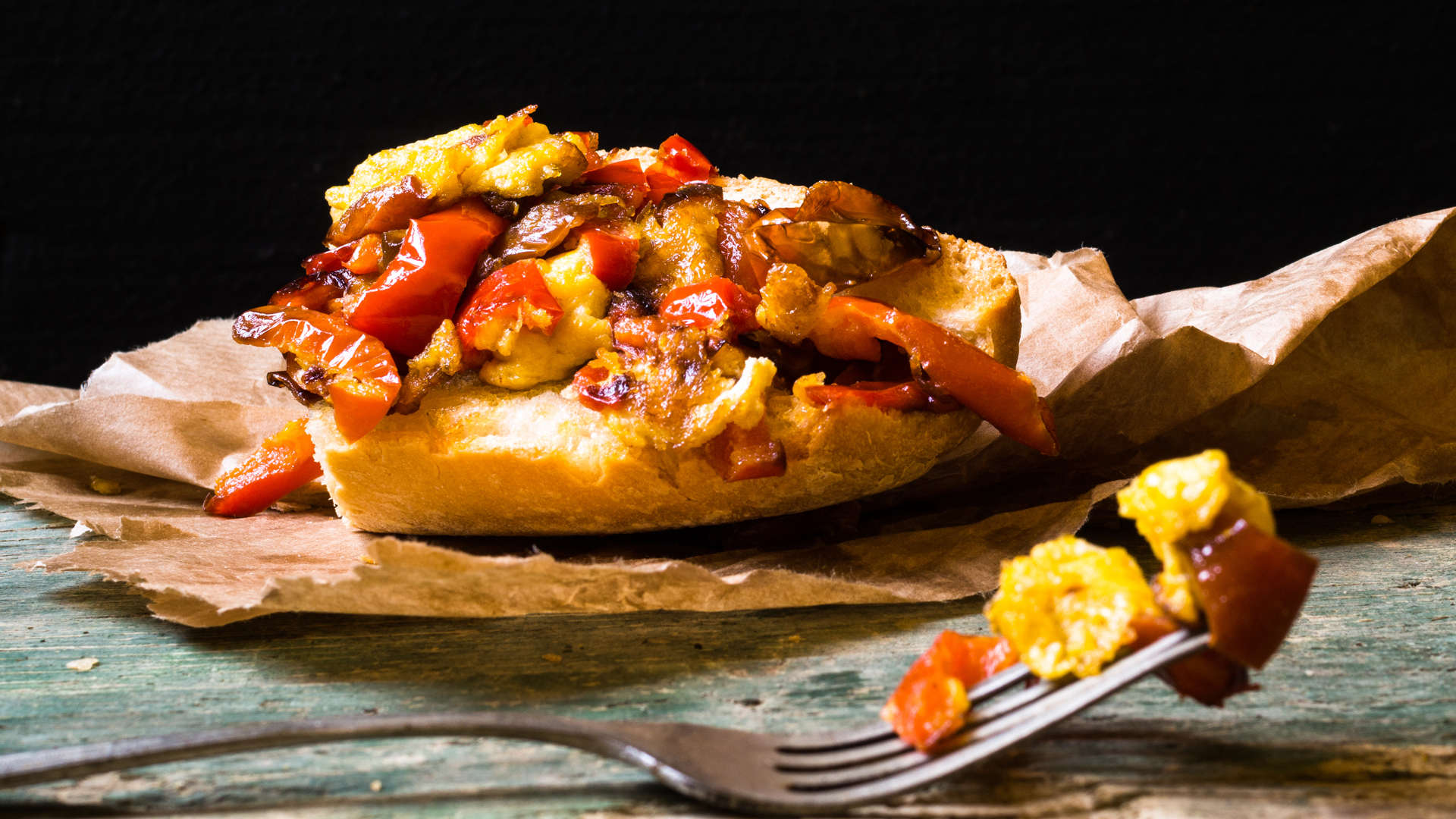It's a simple sandwich as far as sandwiches go: bell or cubanelle peppers cooked soft and combined with eggs, sandwiched on an Italian roll.
There are a few variations on this standard recipe like adding mozzarella or Parmigiano Reggiano into the eggs. The eggs can be loosely scrambled or cooked tight like an omelet. The signature element of the pepper and egg sandwich though is the lack of meat and the reason it became popular with Italians.
The "pepper 'n egg" sandwich is commonly associated with Chicago, and can often be found in the same shops that serve Chicago's more famous sandwich, the Italian Beef. The Italian Beef is a hot roast beef sandwich on an Italian roll served up soaking wet with beef juice or gravy – it's the sandwich at the center of the hit F/X show The Bear. The Italian beef has been a popular Chicago area sandwich for the last century, but the signature ingredient is the very reason why the pepper and egg sandwich is so important.

(Photo Credit: Getty Images)
Catholics were prohibited from eating meat on Fridays until 1966. These restrictions ultimately helped fishermen who relied on the steady demand at the end of each week. In Italian American culinary traditions, the restriction led to the creation of such innovations like shrimp parmigiana, an odd combination for a cuisine that typically shuns combining seafood with cheese. For sandwich shops accustomed to serving Italian beef heroes, the pepper and cheese was a meat-free alternative. But then in 1966, Pope Paul VI changed the rules to limit the prohibition on meat to only include Fridays during Lent.
Michael Fiore of Fiore's Delicatessen claimed in a 2015 interview to have been the first Chicago-land restaurant to feature the pepper and egg sandwich. It has since become ubiquitous across the region's delis and Italian food shops. Fiore's opened back in 1970, but following the pandemic, the family decided to close their doors in 2021.
Ironically, Fiore's Delicatessen first opened four years after the Pope loosened the rules on meat. Nevertheless, the pepper and egg sandwich was popular during Lent, and Fiore's sold enough of them to make them available all year round. It is one of the few places in Chicago to have the sandwich outside of the holiday. The sandwich remains seasonally popular and shops notice a big increase in orders.
While home cooks might have been making pepper and egg sandwiches in the greater Chicago area long before Fiore's opened, restaurants in other cities were serving up the sandwich at least as early as the 1950s. Steve Martorano, author of It Ain't Sauce, It's Gravy, writes that the pepper-and-egg sandwich comes from the south side of Philadelphia, the Italian neighborhood that also gave America the cheesesteak sandwich. Cheesesteak shops would also have needed a meat-free option in order to sell sandwiches on Fridays.
There isn't a definitive link between Philadelphia and the origin of the pepper and egg sandwich, but by the 1950s and 1960s, local Pennsylvania newspapers are filled with advertisements offering it for prices starting at 10 cents. Even when adjusting for inflation, the ads also show that the pepper and egg sandwich was a relatively inexpensive meal, and that might have been part of the appeal.

(Photo Credit: Getty Images)
An early version of the pepper and cheese can be linked to a Manhattan shop on the east side of the city in the 1950s. By the 1930s, Italian heroes had become popular, and a well-known sandwich in New York. In a 1958 Associated Press story distributed to newspapers across the country, Cecily Brownstone wrote about a pepper and egg sandwich she found at a specialty foreign food store located in the East 20s of Manhattan. She called the pepper and egg sandwich a hero-boy.
The recipe Cecily Brownstone published in the article includes parmigiana cheese, an addition that appears more common on the East Coast than in Chicago. This recipe creates something of a mystery since Brownstone mentions her recipe is slightly different from the scrambled eggs and peppers served at the store.
Another bit of confusion with Brownstone's story is that in 1956, a shop called Hero Boy opened in the West 30s of Manhattan. Hero Boy's biggest claim to fame was the invention of the six-foot-long Italian hero intended for parties and large groups. But it also opened as an offshoot of Manganaro Grosserie Italiana, a specialty grocery store – one that specialized in "foreign" Italian foods. There is the possibility of course that Brownstone incorrectly located the shop selling the pepper and egg sandwich. Unfortunately, Manganaro's Hero Boy closed last year.
Meanwhile, since 2014, Don Rodricks, a columnist at The Baltimore Sun, has been trying to make the pepper and egg sandwich the official sandwich of Labor Day, a holiday more often associated with grilling hot dogs and hamburgers. Rodrick's reasoning is the affordable humble sandwich is a perfect "shift-workers lunch," meaning it's an ideal way to celebrate a holiday we owe to the labor movement.
Whether or not it's eaten during Lent, on Labor Day, or simply because it's delicious, the pepper and egg sandwich is an underappreciated Italian American classic.
Ian MacAllen
Ian MacAllen is the author of Red Sauce: How Italian Food Became American. He is a writer, editor, and graphic designer living in Brooklyn. Connect with him at IanMacAllen.com or on Twitter @IanMacAllen.


